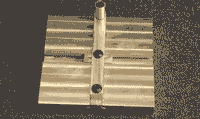 |
Here are the basic cutting
and collet mounted tools you'll be using. The
edge finder, which fits either in a collet or drill chuck, is on the far
left. Then proceeding to the right, the 10-32 tap, #21 drill, #11
drill, 5/16"
end mill, 3/8" end mill, 1/2" end mill, and the T-slot or Woodruff
key seat cutter. The drills are of the "split point" style,
which allows them to start and drill right on center, eliminating the need
for spotting drills to guide the drilling. |
 |
Other tools include a mill file, needle file, tap handle, drill chuck,
various milling machine collets, hex wrenches and a digital caliper. |
 |
For holding work parallel in the vise, there's a set of precision ground
parallels. |
 |
OK, before getting started,
now's the time to check to see that the milling machine is setup and
ready to use. If you're not familiar
with this basic routine, jump over to this little description:
Checking Basic Milling Machine Setup |
|
|
The base is the most complex
part of this assembly, and it's the logical first piece to make because
other parts have to fit it with a fair degree of precision. This
is a 4" x 4" piece of 5/8" thick extruded aluminum. While
some surfaces appear flat they are not as flat or square as the might be. Two
edges are quite rough because the piece was sawed off a longer section.
|
|
|
The first step in truing up
the stock is to place one of the straightest edges downward in the mill
vise so the top edge can be milled flat. There's
a lot of material sticking up from the vise jaws, so you have a serious
limitation on the force you can apply without causing excess vibration. You'll
be taking light cuts so this 5/8" thick aluminum can stand up to
the cutting action. |
|
|
With the 1/2" end mill held
in a collet, take a light cuts across the top of the stock in two passes. If
you run the mill from right to left in the front, and from left to right
at the back edge, you'll be "climb cutting," which will create
less of a ragged bur on the corners of the work piece. Remember,
your goal is to produce a smooth, flat surface without taking off any
more stock than necessary. |
|
|
After each milling operation,
be sure to clean up any rough edges or corners by filing lightly. Not
only will that make the piece safer to handle with your fingers, it will
assure that the metal can be clamped in the vise without having the rough
edge interfere with alignment. Even
though the vise is obviously very strong, it is still important to keep
any little pieces of aluminum from being trapped when the work piece is
clamped. |
|
|
Clean the file frequently.
The easiest and best file cleaner is a simple piece of hardwood you can
simply push along the teeth of the file to clean them. A clogged
file will not only scratch your work, it will simply not cut well at
all. |
|
|
Now, clamp the aluminum block
in the vise making sure to seat the freshly cut edge down against the
bottom of the vise to get a good alignment. Make
a similar cut across the top edge to clean and straighten it just as before. |
|
|
Here's a reminder. Always brush chips away from the vise, and use
a rag to clean the clamping area completely. The same goes for the
work piece. You can't get it square and true without working cleanly. |
|
|
Wipe off and place a pair of
parallels in the vise jaws to support the work piece. Select a
pair that will allow plenty of gripping area for the aluminum - at least
half of its thickness. |
|
|
One really good reason for
squaring stock is so that it can be held rigidly in the milling vise. Clamp the work piece in
the vise using the newly milled surfaces to contact each vise jaw, and
have about 1/2" of the stock hanging outboard so the edge can be milled
with the side of the 1/2" end mill. Take a light cut or
two, just until you have a nice flat cut across the end. Once again,
climb cutting will provide a smoother surface. After you make that
cut, turn the piece around and cut the other edge. |
|
|
Now you have a nice block with
edges that are parallel and at right angles to each other. It's time to square up the piece so all sides
are the same length. Measure the shortest dimension across the block. It
should be just a bit less than the original 4" dimension. |
|
|
You'll want to have a finished
piece that's 3.875" by 3.875" and you
can achieve that with a simple bit of calculation and use of the Z-axis
dial. First, subtract 3.875 from the current dimension to derive
the amount you'll need to cut off. |

|
Clamp the aluminum in the mill
vise so that the dimension you just measured is oriented vertically. Use the quill to lower the 1/2" end mill until
it just touches the top edge of the piece. Lock the quill, and crank
the X-axis handle until the end mill is no longer directly above the piece. |
|
|
This is the dial on the "knee" or "Z-axis" of the milling machine. Loosen
the locking collar, rotate the dial until it reads "zero" and
lock the collar. |
|
|
Now, raise the knee axis by
the amount you calculated. As you can see, my calculation was .075, and
my Z-axis reading is the same. This
particular milling machine has a digital readout on the Z-axis, but that's
rather uncommon. Most mills that are fitted with DRO units only on
the X-axis and Y-axis. So, while you'll be using the DRO for other
measurements, it's best to count on the graduated dial for this Z-axis
movement. |
|
|
With the table raised the appropriate
amount, take a cut across the top of the piece just as before, in two
passes, climb cutting to the left on the front and to the right on the
back. File any rough edges, and
clamp the piece, rotating it ninety degrees to cut the other dimension
with the same table height. |
|
|
If you were careful in measurement, clamping and adjustments, you should
have a nice square work piece, 3.875 x 3.875. |
|
|
Clamp the work piece back in the vise supported by parallels, and take
a light cut across the top. |
|
|
If you go very lightly, you'll
see how uneven the original surface was. Notice
that the piece is actually a bit thinner in the center than at the edges. Raise
the knee a tiny bit, and continue cutting until the surface is nicely
flat and smooth. Flip the piece over, and repeat the process on the
other side. |
|
|
You now have a nice square
piece that's flat on all edges. There's
no critical dimension for thickness, so once it's smooth and flat, it's
ready to go. |
|
|
Once again, another reminder. Keep the clamping area clean of chips. Little
flakes of aluminum like these may seem innocuous, but they will get squished
against the vise jaws and mar the nice surface you just milled. Keep
it clean. |
|
|
OK, now it's time to get serious
about measuring. While the DRO
can help you position the milling cutter precisely, you have to start from
a known reference - the edge. This edge finder is just about the
most important accessory for DRO use. Lower the quill so the end
of the finder is just below the surface of the work, run the spindle
at 500-800 rpm, and slowly move the table Y-axis until the edge finder
just touches the work. It takes a bit of practice, but once you get
the hang of using the edge finder you'll be able to position work with
precision. As soon as the edge finder touches the work, the bottom
section will "kick out" just as in the photo. Approach the
edge several times, and make sure you stop the table movement at the right
spot, just as the finder kicks. |
|
|
Leave the table in that position, and set the Y-axis of the DRO to zero. |
|
|
Now for a bit more calculating. The edge finder has a diameter
of .200", so when it touches the work, the axis of the spindle is centered
exactly .100" outboard of the work. In order to center the work,
you need to add that amount to the distance from the edge to the center. In
this calculation the distance doesn't work out to an even thousandth of
an inch, so I rounded it off. DRO units often read out to fractions
of a thousandth, but for most units, that decimal place isn't exactly reliable. |
|
|
Raise the quill, and move the table Y-axis until it is centered according
to your calculation. |
|
|
Then, set that reading to zero. Any
time you want to return to center, you can move the Y-axis to the zero
mark. |
|
|
Because you'll be making a heavy cut along the X-axis, it's a good idea
to lock the Y-axis so there won't be any unnecessary vibration. |
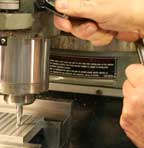 |
Mount the 3/8" end mill and bring the quill down to just touch the surface
of the work piece. Lock the quill. |
 |
Set the knee dial to zero. |
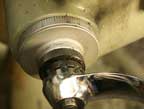 |
Lower the knee a little. |
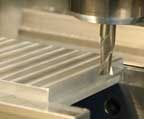 |
Move the X-axis to the right
so the end mill clears the piece. |
 |
Raise the table to the zero
point. Then, raise the table .300,"
which is the depth of the groove you'll cut. |
 |
Taking it slow, and using some
spray lubricant, cut through the piece from one end to the other. You
should have a nice clean groove through the part when you're done. |
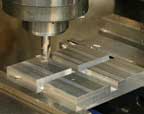 |
Take the piece out of the vise,
clean up and reclamp it after rotating it ninety degrees. Make a second groove through the piece. Now
you have a pair of grooves .300" deep and .375" wide. Because
you took the time to make the piece accurately square, each groove is centered
nicely. |
 |
To widen the grooves to the
final dimension of .400", you need to take
a bit off each edge of the groove. This calculation results in a
measurement that isn't easy to adjust using the DRO, so you can choose
to take .012 off one edge and .013 off the other in order to get the exact
dimension of .400. |
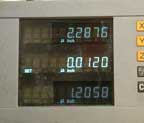 |
Leave the quill locked and, with the tool off to the right of the work,
loosen the Y-axis lock. Move the Y-axis .012. |
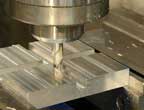 |
Take a nice clean climb cut across the front edge of the groove. |
 |
With the tool outboard on the
left, move the Y-axis forward .013. |
 |
And, cut that amount off the back edge. |
 |
Before you go any further,
mark the piece so you can be sure which edge was cut by which amount. This may seem a bit silly, but since the
grooves are no longer centered, you could introduce an error when you make
the bottom part of the "T-slot." |
 |
A quick check with the caliper
will tell you how close you came to your goal so far. |
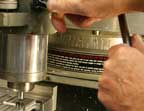 |
With the T-slot or Woodruff
key cutter in the collet, you can set the depth of the cut exactly as
you set the depth for the groove. Lower
and lock the quill so the cutter is just touching the surface of the plate. Then
set the zero on the Z-axis dial, lower the knee a little, move the x-axis
to move the tool from above the piece, and raise the knee exactly .300. |
 |
Return the Y-axis to zero, and lock the Y-axis just as before. |
 |
Again, using plenty of lubricant,
make the T-slot cut through the length of each groove. The lube
is likely to wash off all or part of your marks on the top, so be ready
to renew them as you work! |
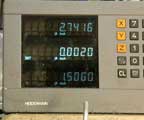 |
Now, just to make the T-slot
even with the original groove, and to clean up the tool marks, you'll
want to climb cut each edge of the T-slot. Move
the table away from you by .002. |
 |
Take a climb cut off that front
edge - the one you cut by .012 when you
made the groove. |
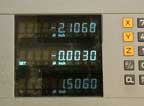 |
And, repeat for the back edge,
this time moving the table forward by .003 so you can make the cut at
the back edge where you had removed .013"
from the original groove. |
 |
Well, that's it. Now
you have a nice base for your two-slider, and it has clean, even T-slots
at right angles. |
 |
In order to fit the sliders, you'll
want to make accurate measurements of the slots in all dimensions. |
 |
It's no real problem if the
measurements are not quite what you were aiming for as long as you
use the actual dimensions for reference when you're making the sliders. |
 |
The sliders are brass, for
easy machining, and smooth gliding in the aluminum T-slots. The
sliders are to be 1" long, so it pays
to start with a piece that's about 2.25". The finished sliders
are short, so it's easier to make them as a single long piece to be cut
in half after it is fitted to the slots. |
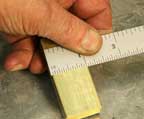 |
This particular piece of brass is a bit wide, but that's no problem. |
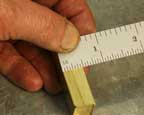 |
It's 1/2" thick, leaving
just enough for cleanup and dimensioning to fit. |
 |
First, trim both ends nice and square, cutting as little off as possible.
Grip the brass in the mill vise, supported with parallels. |
 |
Stand the piece on edge; clamp
it down and mill one edge clean and flat. Whenever
possible, it's a good idea to clamp small parts in the center of the vise
so clamping pressure is more evenly distributed. |
 |
Flip the piece over and mill
the other edge parallel and flat. Don't
forget to file those corners so the piece will be easy to hold! |
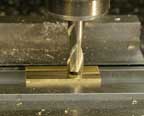 |
Lay the brass flat on the parallels and mill both faces flat. |
 |
OK, more calculation. Measure
the final width of the brass. |
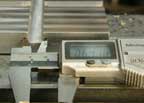 |
And, the width of the T-slot bottom. |
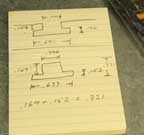 |
Here are my measurements. My T-slot has a width
of .641 at the bottom, so I want my brass slider to be that same width
MINUS .004" or so for easy sliding clearance. So, my slider
should have a maximum width of .637 or possibly a tiny bit less. My
brass was .957" wide, so subtracting the final width of .637, I know I
need to take off exactly .320" to achieve the result I want. |
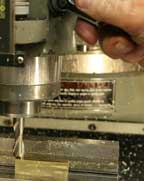 |
Touch the end mill to the work, lock the quill, set zero on the Z-axis
dial, lower the knee just a bit and move the table so the bit is away from
the brass piece. |
 |
Return the Z-axis to zero and raise the knee by the amount you calculated
- in my case that was .320, or three full revolutions plus .020. |
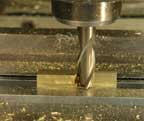 |
Make that cut across the brass just as you did the aluminum, climb cutting
the front and back. |
